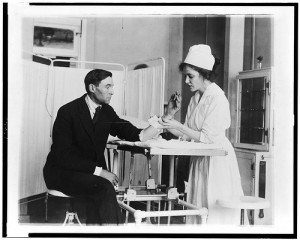-
Rennie and I just returned from a visit to the International Masters in Health Leadership (IMHL) program at McGill, where we did a presentation on many of the themes of this blog. One of the participants said something that struck me about the potential of expressive change taking root in hospital settings. He said that it seems the closer you are to the patient’s bedside, the more autonomy you have and the more you are able to live out the deep values of healing and caregiving. The further out you go, the more instrumental you become.
So if this is true, perhaps a practice that would help nurture expressive change in a hospital setting would be to have as many people engaging with patients as possible, not just the nurses, doctors and aides. How might the accountants, janitors and administrators spend more meaningful time with patients? How might doing this heighten their ability to participate in and receive the gifts the hospital has to offer? And what if we thought more creatively about how to increase the time that doctors and patients spend together. The bedside time seems to be dwindling due to cost-cutting measures, but maybe we can re-think hospital spaces and rhythms in a way that allows doctors to interact informally with patients who are not in their direct care.
A healing culture





6 Responses and Counting...
It strikes me that this is also the case in school settings. The more people interact with students, and thus feel personally connected to the human mission of the school’s project, the deeper the learning is for everyone connected to the organization. One of the great privileges of working in a small school is knowing that the comptroller, the administrative assistants, and the buildings and grounds coordinators are all invested in the mission of the school – because the mission is not abstract, it’s Stephanie, Hamish, David… The more connected you are to students, regardless of your role in the organization, the more “you are able to live out deep values” associated with education.
It’s making me think about my own recent organizational experiences with Santropol Roulant and the Centre for Community Organizations. Both rely heavily on phone interactions to do their work, however, neither has a designated staff person to answer phones. When the phone rings, anyone in the organization is just as likely to pick up. I have personally found that this seemingly small, shared act has deep and far-reaching effects. At COCo, I’ve become much more knowledgeable about the diversity of people who are in relationship with the organization, which has led me to approach my work from a much more holistic perspective. I’ve also found that answering the phone gives me greater insight into the mission of COCo because I am asked to explain what the organization does on a regular basis and because I witness the many different ways that COCo provides support to community groups. I also find it has helped me to become more collaborative and creative in that I have a richer and more complex web of knowledge and relationships to pull from. When I take a phone message for Sarah, I might find out something that helps me with another project I’m working on with Alex.
What I find interesting is that before moving to Montreal, all of the organizations I worked for had an administrative assistant whose main job it was to take calls and funnel them to the appropriate person. This seems very strange to me now and I think I would have a hard time reverting back to that model. I’m not suggesting that every work place should work in this way (for some, the challenges might outweigh the benefits), but I think it’s something to at least consider.
Neat post… I find that it raises all sorts of questions about our relationship to health / health care. I wonder if these are questions we need to bring into our organizations more frequently – to acknowledge our complex relationships to our own health and to view that as an integral part of our work as a group. I’m currently looking into alternative health plans in place in organizations that have chosen NOT to work with insurance providers and find this post inspiring in that regard.
Thanks for your comment, Alex. It is funny how we so often leave the most important parts of ourselves at the door when we go to work, especially something so basic like attention to our health.
It occurs to me that when you dig into the deepest meaning of health, a huge part of what contributes to a healthy life is the quality of our relationships with each other. It seems like the more we divide ourselves from each other, the sicker we become…which is bringing to mind an article, written by Don deGuerre’s and his colleagues, about the effects that hierarchical organizational structures have on employees’ mental health and use of sick days. The article focuses on organizational structure, but I think that there are many aspects of our work lives that have more of a divisive than uniting effect on us, and thus contribute to sickness. I could be working in a hospital with a flat structure, yet still assume that it would be inappropriate for a doctor to share her own personal health challenges with a patient. Or I might never consider that someone in the accounting department could contribute to a patient’s healing process. It seems like our work lives are filled with these kinds of assumptions about role boundaries, and that when we transcend them, we are happier, more creative, and healthier.
The situation of health and mental health in the workplace has become an emergency! and yet, the operating standards used in organisations are difficult to question and challenge their practices are so deeply rooted. One indication of the chink in this way of doing things is how widespread the use of irritating recorded telephone answering systems for the benefit of efficiency. At Skol, one of the practices that we have adopted is to rotate who sits at the front desk (haha that sounds weird, like they swivel). This position is one that allows interaction with visitors to the gallery. It used to be a position held by the intern, or other temporary staff, i.e. the (sometimes) least invested person in the joint.
That’s great, Anne. What a nice concrete practice. You invert all of our usual assumptions about who should do the function of “reception” (phones/greeting visitors, etc.). As you say, what if instead of seeing this function as low-status and entry-level, we recognized its importance? I think in general it is often healthiest to have everyone participating in answering phones (whether rotating as at Skol, or simply having whoever is free grab the next ring), but if we were going to pick only one category of people to do it, wouldn’t it make sense that it be the people who were most deeply invested in and experienced with that org, which might in many cases be the executive director, board president, etc.? It makes me laugh to imagine a world in which one of the primary responsibilities of any executive director is to sit by the entrance to the office and answer phones. Our friend Mark McGuire says that one of the most engaging organizations he has ever been involved with was a middle school in Japan where the principal spent a lot of his time in sweatpants trimming the bushes, cutting the grass, and chatting with the visitors, staff, and students who passed by as he did it.